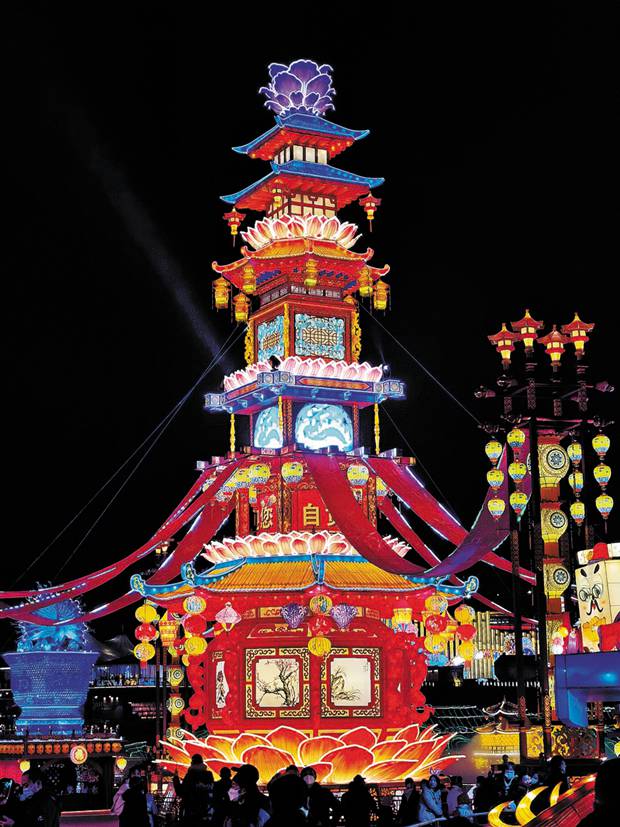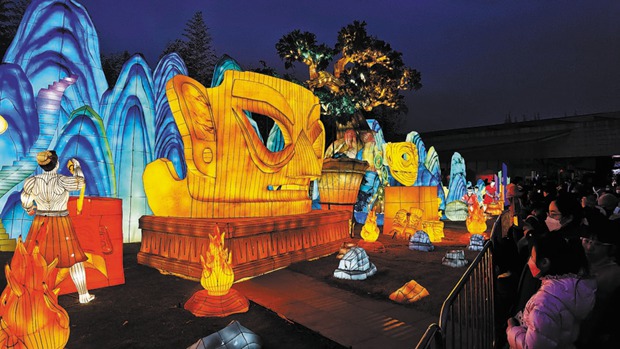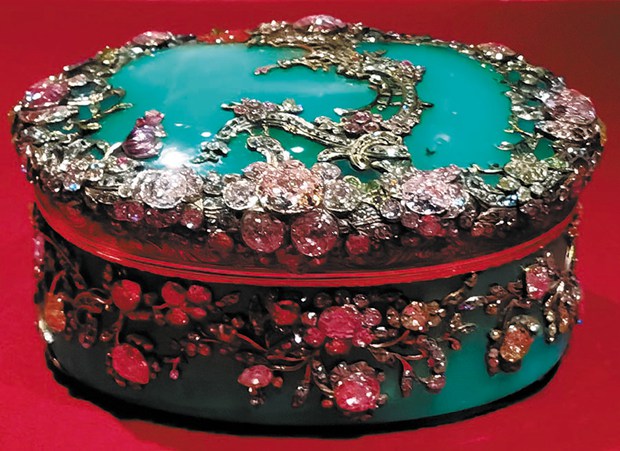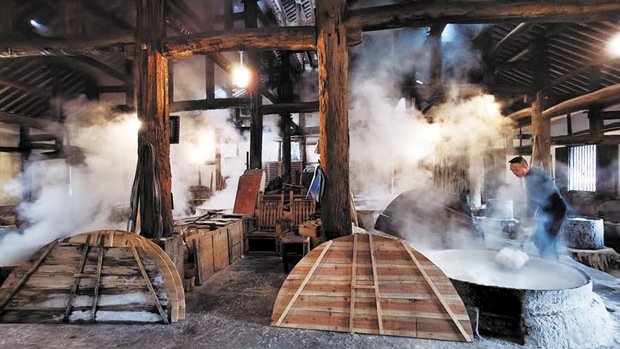Mining has seen ups and downs but traditional condiment continues to appeal, report Huang Zhiling and Tao Xiaoli.
Any mention of Zigong, Sichuan province, reminds people of its salt production and, until recently, this was an important source of revenue.
The city, about 200 kilometers from Chengdu, capital of Sichuan province, has a history of mining salt stretching back 2,000 years. The salt was sold all over Sichuan, Yunnan, Guizhou, Hunan and Hubei provinces, and was consumed by one-tenth of China's population.
The salt is extracted from wells. One of them, the Shenhai well, was opened in 1835, and is still in operation.
With a depth of 1,001.42 meters, it is among the world's deepest of its kind and currently produces around 2,000 kilograms of salt per day.
Visitors to the well can buy packs of iodine-free salt that was mined just three days earlier. According to Xiao Ling, an official in charge of the well, one 400-gram pack costs 10 yuan ($1.45) and is hugely popular with visitors.
But, during Spring Festival, which ends with the Lantern Festival on the 15th day of the first lunar month — falling on Sunday this year — more people from around the country flock to Zigong to view its world-famous lanterns.

This year's rabbit lantern, 26 meters tall and 15 meters wide, is the largest rabbit in Zigong's lantern show history. [PHOTO BY LIU LANYING/FOR CHINA DAILY]

A pavilion at the lantern show in Zigong, Sichuan province. [PHOTO BY LIU LANYING/FOR CHINA DAILY]
Viewing lanterns became a Spring Festival custom in Zigong during the Tang Dynasty (618-907).The city's lantern show has been held in more than 70 countries and regions around the world, becoming a calling card of both Zigong and China.
However, the popular show originated from the city's economic plight in the 1980s.
Before the Sixth Five-Year Plan (1981-85), Zigong's economy, dominated by the salt industry, exceeded the national economic growth rate and made it Sichuan's third largest industrial city.
But its overreliance on a single product became a problem by the late '80s. Salt output in Hunan and Hubei provinces rose sharply and some other cities and counties in Sichuan started producing their own salt.

Visitors appreciate lanterns featuring ancient Shu elements (Sichuan being called Shu in ancient times), represented by distinctive masks at the Jinsha Site Museum in Chengdu, Sichuan. [PHOTO BY LIU LANYING/FOR CHINA DAILY]
This growing competition had an impact on the revenue of Zigong's salt enterprises, and the city's economic growth rate lagged behind that of newer industrial cities in Sichuan.
To celebrate Spring Festival in 1987, Zigong held a 40-day lantern show. The city of some 3 million people attracted 2.3 million tourists.
The success prompted local authorities to treat the lantern show as a new economic growth point and they decided to host the show on other dates as well, not just during Spring Festival.
In the summer of 1988, Zigong held a 46-day show in Beijing's Beihai Park. It was a great financial success and ensured national publicity for Zigong's lanterns.
In the autumn of 1990, Zigong was approved by the former Ministry of Culture to hold a 17-day show in Singapore, which was the first time the city took their trademark lanterns overseas.
Since then, Zigong has held the show in 76 countries and regions around the world, according to Yang Bin, deputy chief of the publicity department of the Zigong municipal committee of the Communist Party of China.

Frederick the Great snuffbox, made in Germany, is on show at the Jinsha Site Museum in Chengdu. [PHOTO BY LIU LANYING/FOR CHINA DAILY]
As this is the Year of the Rabbit, the show, which started on Jan 17 and ends on March 31, has the largest rabbit in Zigong's lantern show history — 26 meters tall and 15 meters wide. Children rush to pose for photos in front of it.
Diarra Boubacar Thiemoko, a native of Mali in Africa who lives in Chengdu, said during his visit to the show on Jan 17 that this was his third visit.
"Each time, I make new discoveries. Zigong's lantern show gets better each year," says the 58-year-old traditional Chinese medicine practitioner.
The show this year is unique because it features ancient Shu elements (Sichuan was called Shu in ancient times), represented by distinctive masks and gigantic ivories from the Sanxingdui Ruins in Guanghan, Sichuan.
The ruins were discovered in 1929 by a farmer digging a ditch.
Findings at the site confirmed that it housed the ruins of an ancient city that was the political, economic and cultural center of the "ancient Shu kingdom", established between 2,800 and 4,800 years ago.
One of China's most important archaeological discoveries of the 20th century, the ruins, located on the upper reaches of the Yangtze River, provide convincing proof that the origins of Chinese civilization are diverse, contradicting theories that suggest the Yellow River is the sole point of origin, according to Duan Yu, a historian with the Sichuan Academy of Social Sciences.
The Beautiful Sky of Italy, a glass micromosaic, inlaid on a gilt bronze table made in Rome, Italy, is on show at the Jinsha Site Museum in Chengdu. [PHOTO BY LIU LANYING/FOR CHINA DAILY]
An 18-day large lantern show at the Jinsha Site Museum in Chengdu, which ends on Sunday, also features ancient Shu elements.
Many of the exhibits at the Sanxingdui Museum that was built on the archaeological site look similar to those found and displayed at the Jinsha Site Museum, built on Jinsha Ruins.
It is assumed that inhabitants of Sanxingdui moved to Chengdu after a disaster, such as a flood, befell the city, according to Zhu Zhangyi, archaeologist and curator of the Jinsha Site Museum.
Archaeologists hail the Jinsha Ruins as one of Sichuan's most important archaeological findings since the discovery of the Sanxingdui Ruins.
On Feb 8, 2001, when builders were working at a construction site at Jinsha village, Chengdu, they found ivory and jade articles in the piles of mud.
Since then, archaeologists have excavated some 10,000 relics, including gold, jade, bronze and stoneware, as well as ivory, pottery and ceramic pieces.
Visitors to the Jinsha Site Museum will pay 70 yuan for admission to this year's lantern show, but will also be able to enjoy the relics on display at the museum.

A worker takes away salt, made by boiling brine from the Shenhai well in Zigong, Sichuan province. [PHOTO BY LIU LANYING/FOR CHINA DAILY]
They can also attend a lacquerware exhibition in Chengdu and Sichuan's neighboring Chongqing municipality, which ends on March 16, as well as an exhibition featuring treasures from the world-famous Rosalinde and Arthur Gilbert collection, which ends on March 19.
The Sichuan Basin is rich in natural lacquer, and Chengdu and Chongqing have long been an important lacquerware production base. More than 3,000 years ago, during the ancient Shu period, Sichuan was associated with lacquer.
A gold-faced bronze head with raw lacquer and clay used as a paste was unearthed in Sanxingdui. Relics, such as jade lacquered wood and a wood-tipped tiger head, unearthed in the Jinsha Ruins bear witness to the ancient Chengdu lacquer art, Zhu says.
The Gilberts, who made their first fortune by launching a fashion label in London in the 1930s, made a name for themselves with their superb collection of gold, silver and micromosaics, which marked one of the most comprehensive private collections in the 20th century European decorative arts circle.
Gifted to the United Kingdom, the collection has been safeguarded by the Victoria and Albert Museum in London since 2008.
Ninety exhibits, spanning from the 16th to 19th centuries in Europe, are on display at the Jinsha Site Museum.
After appreciating lanterns on Jan 25, Liu Yiwen, a senior middle school student in Chengdu, was impressed with the gold beaker and stand made in Russia in the 1760s, the engraved silver soup tureen made in England between 1806 and 1807, the engraved silver wine cooler made in England between 1794 and 1795, and the Frederick the Great snuffbox, made in Germany in 1765.
"They belong to a different culture, but are as meaningful and awe-inspiring as the Chinese relics on display at the museum," says the young visitor.














